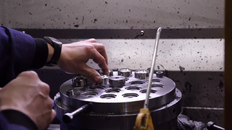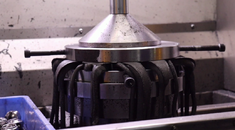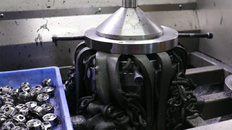I appreciate you sharing information here; it is rare for a company to put themselves out there like this. I would love to get feedback on the following points:
1. Oxygen Service
You use stainless steel extensively in your regulator line-up. I understand the appeal of a more corrosion-resistant material, but I see several critical points that should be addressed, as stainless steel has significantly inferior thermal properties compared with C36000 brass.
- Iron(III) oxide has a standard molar enthalpy of around –1100 kJ/mol, while copper (the main component of brass) has only about –150 kJ/mol. This is especially concerning with respect to particle impacts and high-oxygen usage.
- A similar picture emerges when considering heat of combustion. Brass generates approximately Δh of around 2.9 kJ/g, whereas steels produce well above 7.5 kJ/g; at least twice the amount. This means that if a small portion of material were to ignite, stainless steel is far more likely to sustain a fire and be part of the kindling reaction, whereas brass could possibly extinguish it naturally.
- Brass also has significantly higher thermal conductivity; around four times that of stainless steel. In oxygen service, this helps to spread local hotspots, such as those from adiabatic heating, reducing the risk of ignition.
2. Cold Water Performance
As noted above, brass is a far better thermal conductor. This aids in heat (or more accurately, cold) dissipation after the orifice edge. Similar piston designs made from brass have been shown to comply with EN 250 cold-water requirements. How does the S1 perform under cold conditions? The use of stainless steel would suggest that it may not pass the cold-water auxiliary test.
3. Galvanic Corrosion
316L stainless steel is high in the galvanic series, well above brass and chromium. Hoses are almost universally made from free-machining brass (C36000) or similar alloys. This introduces an inherent problem in the design: a “big cathode, small anode” effect, where the mass of the first stage is vastly larger than that of the hose end.
Are you mitigating this risk somehow? If not, and it is truly not an issue, I would be interested to understand why. The underlying physics and chemistry are straightforward, and I have seen similar setups in oxygen units where this caused major problems. The standard electrode potentials of brass, chromium, and 316L stainless steel differ significantly, making galvanic corrosion a likely possibility.
4. Filter
From the pictures, it appears that you use flat polymer filters. I have nothing against polymer filters in principle, as I understand they help reduce cost. However, I assume you are not using these polymer filters in your oxygen units, as they would be utterly out of place. Are you using sintered bronze filters, as is standard in the diving and medical oxygen industry, or stainless steel mesh filters? If stainless steel mesh is being used, how are you mitigating what I see as a very high risk of oxygen fire within the filter? Literature repeatedly shows that stainless steel mesh is incompatible with oxygen service.
1
I am not a fan of disc filters; would it not be possible to use a conical design, even without incurring the cost of a sintered bronze filter? The small surface area of a disc filter is inferior to a conical shape for safety and flow distribution. Flat discs clog up much quicker than their conical siblings.
Again, thank you for giving us the opportunity to ask questions about some of these design choices, I always enjoy getting an engineers perspective.
1 ASTM - Flammability and Sensitivity of Materials in Oxygen-Enriched Atmospheres, 10th Volume (2003), among many others.










